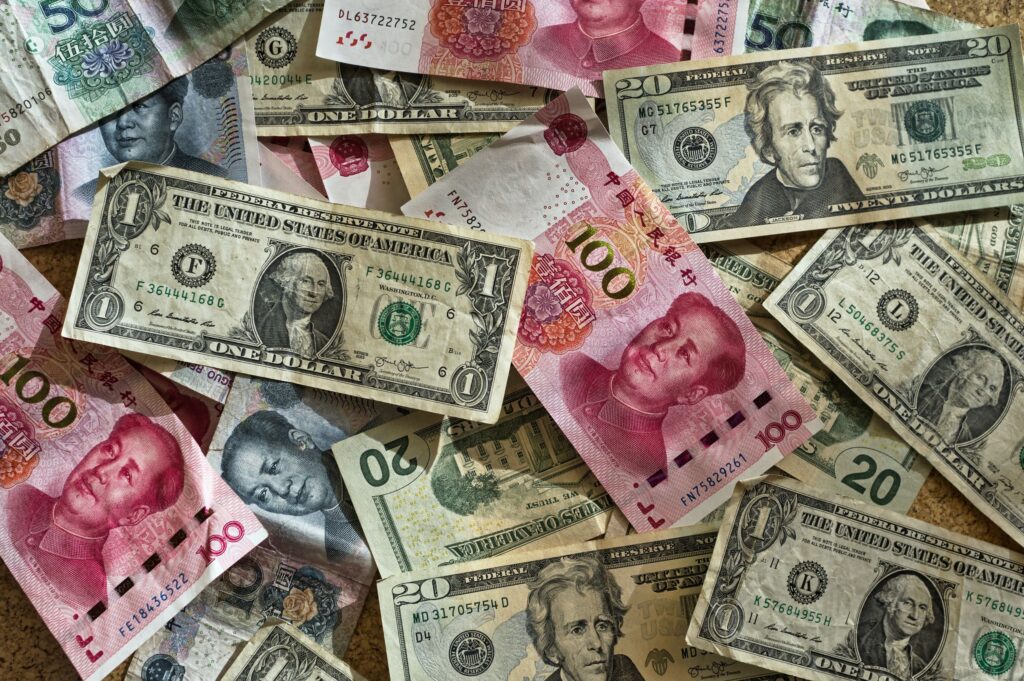
Despite the divergence in the US and China’s monetary policies over the past two months – with the Federal Reserve signaling its intent to raise rates and the People’s Bank of China taking steps to cut its policy loan rate – the yuan has continued its rally against the dollar. What is driving the appreciation in the yuan? Where is the currency headed?
Trade balance and capital flows generally guide the movements of a currency’s exchange rate, with the latter having a considerably heavier bearing than the former. According to a report by the World Trade Organization, global trade volume in 2019 stood at US$25 trillion, while the daily foreign exchange transactions in April 2019 averaged US$6.6 trillion, statistics from the Bank for International Settlements showed. This means that merely four days’ worth of foreign exchange transactions would suffice to meet the foreign exchange trading demand for the entire year. As for the remainder of foreign exchange transacted, some could be used as a hedge against risks in balance sheets, or for purchasing foreign assets, but most of it is likely attributable to speculative trading.
Given that China’s capital account remains partially closed, the influence of speculative trading on the yuan’s rate would understandably be smaller.
In terms of trade, China’s foreign-currency reserve has benefited from a pandemic-driven export boom and a slump in outbound tourists in the past two years, which boosted its foreign exchange inflows, thus supporting RMB to appreciate steadily. However, with European countries and the US keeping their borders open amid the pandemic, the gradual return to normalcy will likely give rise to more demand for services, while hitting demand for goods. As such, China’s export and trade surplus will start to feel the pinch, but it will also relieve some of the appreciation pressure on the yuan.
While the numbers suggested that speculative trading could be an important factor in moving foreign exchange rates, those trades were still, to a greater or lesser extent, heeding various economic indicators – two of the key ones are inflation rates and interest rates.
The higher the inflation rate in a country, the more depreciation pressure its currency is usually under. Consider the following scenario in which Country A has higher annual inflation than Country B. Over the course of a year, the production cost in Country A will have swelled at a quicker pace than in Country B, which has lower inflation. Should Country A fail to improve its production efficiency within a short span of time, the competitiveness of its export will drop, putting Country A’s currency under depreciation pressure; on the other hand, Country B’s exports will become more competitive relative to Country A’s, thus strengthening its currency.
Year-on-year figures in December last year showed that China’s CPI (consumer price index) rose by 1.5%, the US’s by 7%, and that of the eurozone economy by 5.3%. The fact that China’s inflation rate was lower relative to Europe and the US offered a partial explanation for the yuan’s strength over the past year.
But we think that China’s inflation rate will likely remain stable over the coming six months, primarily because pork prices were hovering at elevated levels in Q1 last year. Due to the high base, there should be less inflation pressure in H1 this year. Secondly, with China’s economy at risk of a slowdown, it will be more difficult for companies to pass on rising costs to consumers.
As for Europe and the US, we think inflation will begin to taper this year as supply chain bottlenecks ease. However, due to the unprecedentedly loose monetary policies and increased government handouts in the past two years, the abundance of hot money still circulating in the economies will be an obstacle for inflation rates to fall back to the central banks’ 2% target. Instead, we think the lowest level the inflation rate will likely reach this year is around 4%.
While China’s inflation rate is still lower than that of Europe and the US, the divergence between them will likely narrow in the coming year, which should contain the appreciation pressure on the yuan.
In addition to the inflation factor, another impetus for the yuan’s surge is China’s higher interest rates relative to that of other countries. As of early February, 10-year Chinese government bond (CGB) yields stood at ~2.7%, compared to around 1.9% for US Treasuries and around 1%+ for government bonds in the euro area. Clearly, the potential returns that CGBs were offering were more attractive than their counterparts. While China is faced with pressure to cut rates this year, accelerating inflation in Europe and the US will continue to push interest rates up, while also giving the yuan some respite from the appreciation pressure.
Having considered the macroeconomic factors above – trade, inflation, and interest rates – we think the rising streak of the yuan may not come to a stop in H1 this year; but given China’s weakening exports, as well as Europe and the US’s easing inflation as they move to hike interest rates, the extent to which the yuan will appreciate should narrow compared with levels seen last year.
Disclaimer
This document is based on management forecasts and reflects prevailing conditions and our views as of this date, all of which are accordingly subject to change. In preparing this document, we have relied upon and assumed without independent verification, the accuracy and completeness of all information available from public sources. All opinions or estimates contained in this document are entirely Zeal Asset Management Limited’s judgment as of the date of this document and are subject to change without notice.
Investments involve risks. Past performance is not indicative of future performance. You may lose part or all of your investment. You should not make an investment decision solely based on this information. Each Fund may have different underlying investments and be exposed to a number of different risk, prior to investing, please read the offering documents of the respective funds for details, including risk factors. If you have any queries, please contact your financial advisor and seek professional advice. This material is issued by Zeal Asset Management Limited and has not been reviewed by the Securities and Futures Commission in Hong Kong.
There can be no assurance that any estimates of future performance of any industry, security or security class discussed in this presentation can be achieved. The portfolio may or may not have current investments in the industry, security or security class discussed. Any reference or inference to a specific industry or company listed herein does not constitute a recommendation to buy, sell, or hold securities of such industry or company. Please be advised that any estimates of future performance of any industry, security or security class discussed are subject to change at any time and are current as of the date of this presentation only. Targets are objectives only and should not be construed as providing any assurance or guarantee as to the results that may be realized in the future from investments in any industry, asset or asset class described herein.



